Mastering steeping times is essential for your homemade tea blends. For delicate green teas, aim for 1-3 minutes, while robust black teas need 3-5 minutes. White teas are best at 1-3 minutes, and oolongs can range from 1-5 minutes depending on the infusion. Herbal infusions and tisanes benefit from longer steeps of 5-7 minutes. Rooibos and honeybush can steep for 5-10 minutes, while yerba mate takes 3-5 minutes. Fruit tea mixtures steep well at 3-5 minutes hot, or 4-12 hours cold. Floral blends often require just 2-3 minutes. By fine-tuning these times, you'll access the full potential of your unique tea creations.
Delicate Green Tea Blends
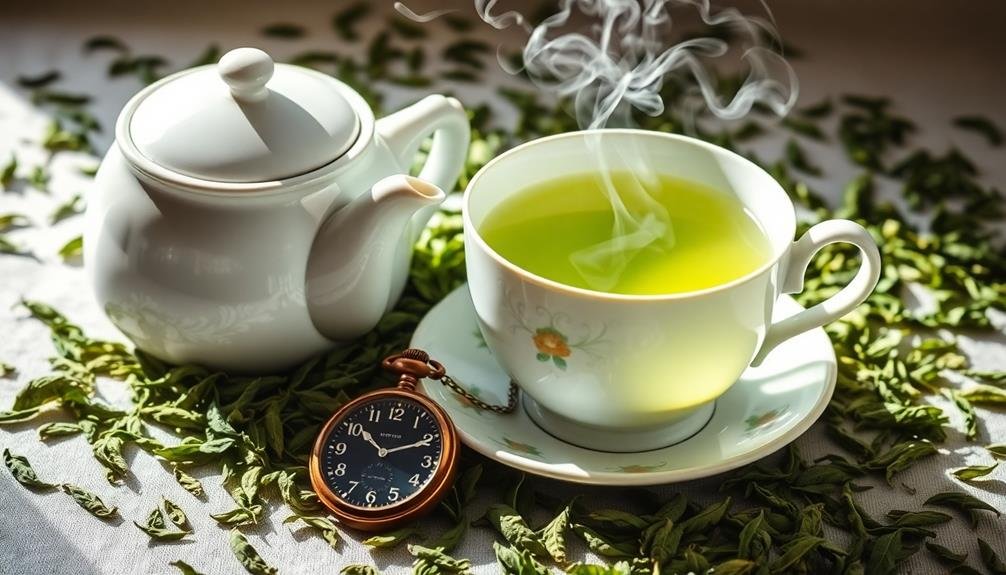
When it comes to delicate green tea blends, proper steeping time is essential. You'll want to aim for a short steeping period to avoid bitterness and preserve the tea's subtle flavors. Generally, steep your green tea blends for 1 to 3 minutes in water that's around 160-180°F (71-82°C).
For lighter green teas like Japanese Sencha or Gyokuro, stick to the lower end of the spectrum, steeping for just 1-2 minutes. These teas are more delicate and can quickly become overpowering if steeped too long.
For Chinese green teas like Longjing or Gunpowder, you can extend the steeping time to 2-3 minutes.
If you've added other ingredients to your green tea blend, such as herbs or dried fruits, you might need to adjust the steeping time slightly. Herbs often require longer steeping, so consider brewing them separately and adding them to your green tea afterward.
Robust Black Tea Combinations
Unlike delicate green teas, robust black tea combinations require longer steeping times to fully develop their rich flavors and aromas. When brewing black tea blends, you'll want to aim for 3 to 5 minutes of steeping time. This allows the tannins to release and creates a full-bodied cup with depth and complexity.
To attain the perfect steep for your black tea combinations, consider these factors:
- Water temperature: Use water that's just off the boil, around 200-212°F (93-100°C)
- Leaf-to-water ratio: Generally, use 1 teaspoon of tea per 8 ounces of water
- Tea quality: Higher-quality teas may require shorter steeping times
Experiment with different steeping times to find your preferred strength. If you're adding milk or sweeteners, you might want to steep for an extra minute to guarantee the tea's flavor holds up.
Remember that oversteeping can lead to bitterness, so it's better to start with shorter times and adjust as needed. For iced black tea blends, consider cold brewing overnight or doubling the tea leaves when hot brewing to compensate for dilution from ice.
Herbal Infusions and Tisanes
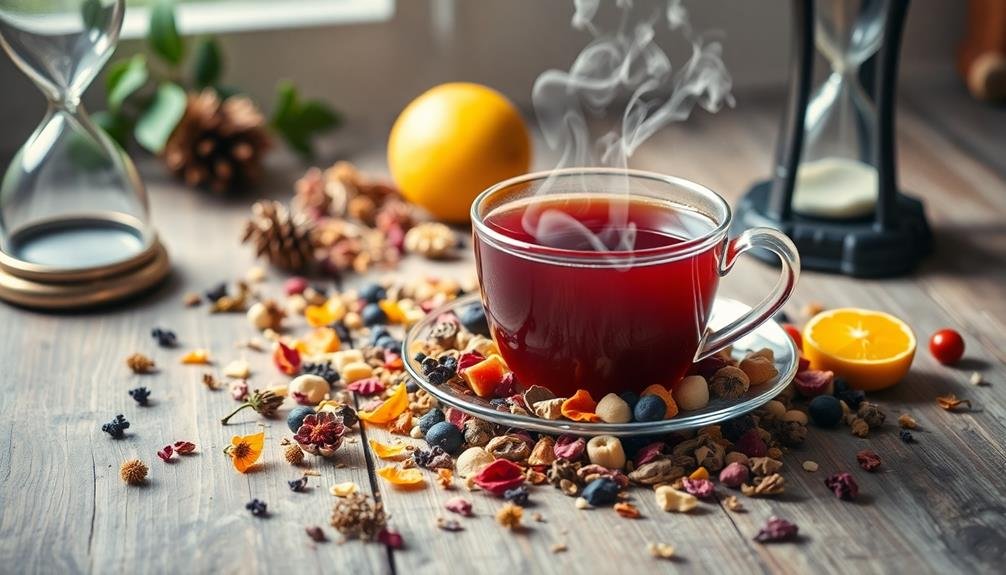
Herbal infusions and tisanes offer a world of flavors beyond traditional teas. Unlike true teas, which come from the Camellia sinensis plant, these blends can include a variety of herbs, flowers, fruits, and spices. When steeping these caffeine-free alternatives, you'll want to adjust your timing to extract the best flavors and benefits.
For most herbal infusions, you'll find that longer steeping times are beneficial. Here's a quick guide to help you get started:
| Herbal Blend | Steeping Time | Water Temperature | Flavor Profile |
|---|---|---|---|
| Chamomile | 5-7 minutes | 200°F (93°C) | Floral, sweet |
| Peppermint | 5-7 minutes | 212°F (100°C) | Cooling, crisp |
| Rooibos | 5-7 minutes | 212°F (100°C) | Nutty, smooth |
| Hibiscus | 5-7 minutes | 212°F (100°C) | Tart, fruity |
Oolong Tea Steeping Guidelines
Between green and black teas lies the complex world of oolong. These partially oxidized teas offer a wide range of flavors and aromas, from light and floral to rich and roasted. When steeping oolong, you'll want to pay close attention to both water temperature and steeping time to get the best results.
For most oolongs, you'll want to use water that's around 185-205°F (85-96°C). Start with a shorter steeping time of about 1-2 minutes for your first infusion. Oolong teas are known for their ability to be steeped multiple times, with each infusion revealing new layers of flavor.
Here are some key points to remember when steeping oolong tea:
- Use about 1 teaspoon of loose leaf oolong per cup of water
- Increase steeping time by 30 seconds to 1 minute for each subsequent infusion
- Experiment with different steeping times to find your preferred flavor profile
As you become more familiar with oolong teas, you'll develop a sense of how different varieties respond to various steeping methods.
Don't be afraid to adjust times and temperatures to suit your taste preferences. The beauty of oolong lies in its versatility and the unique experience each cup can offer.
White Tea Brewing Techniques
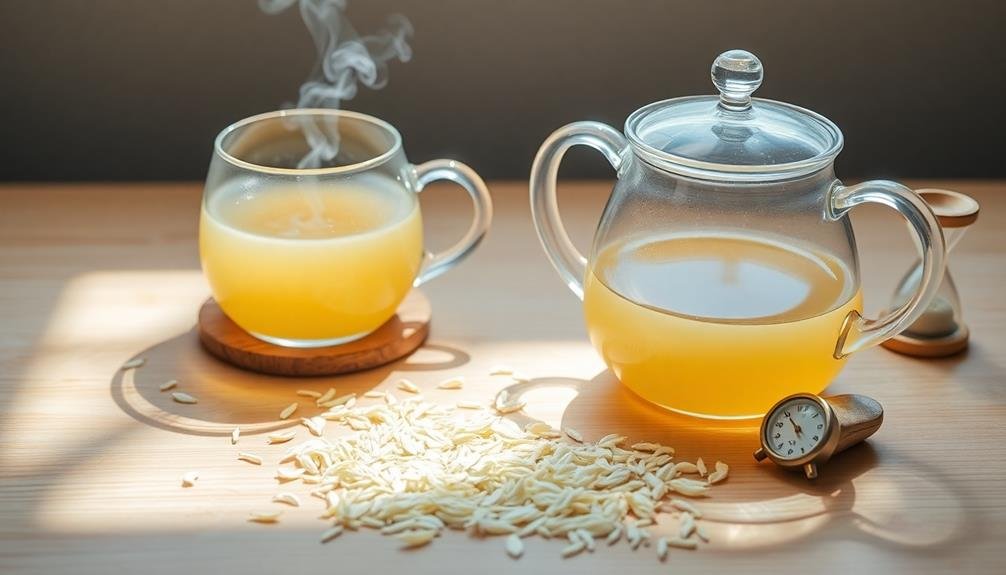
With a delicate nature and subtle flavors, white tea requires a gentle touch when brewing. You'll want to use water that's cooler than what you'd use for other teas, typically between 160°F and 180°F (71°C to 82°C). If you don't have a thermometer, let boiling water cool for about 5 minutes before pouring it over your tea leaves.
For loose leaf white tea, use about 1.5 to 2 teaspoons per 8 ounces of water. Place the leaves in an infuser or tea ball, or directly in your cup if you'll be straining later. Steep for 1 to 3 minutes, tasting every 30 seconds until you reach your desired strength.
Be careful not to over-steep, as white tea can quickly become bitter. If you're using white tea bags, follow the same temperature guidelines but steep for only 30 seconds to 2 minutes.
Chai Spice Blend Timing
Wondering how long to steep your homemade chai spice blend? The perfect chai steeping time depends on your desired strength and the specific ingredients you've used. Generally, you'll want to steep your chai blend for 3 to 5 minutes in boiling water.
For a stronger, more robust flavor, consider these tips:
- Use freshly ground spices to intensify the taste
- Simmer the blend on low heat for 10-15 minutes instead of steeping
- Add black tea leaves during the last 3-5 minutes of simmering
If you're using a pre-made chai spice mix without tea leaves, steep it for 5-7 minutes to allow the flavors to fully develop. Remember, the longer you steep, the stronger and spicier your chai will become. For a milder taste, stick to the lower end of the steeping time range.
When adding milk to your chai, do so after the steeping process is complete. This guarantees that the spices have had enough time to release their flavors into the water.
Experiment with different steeping times to find your perfect chai balance, and don't be afraid to adjust based on personal preference.
Rooibos and Honeybush Steeps
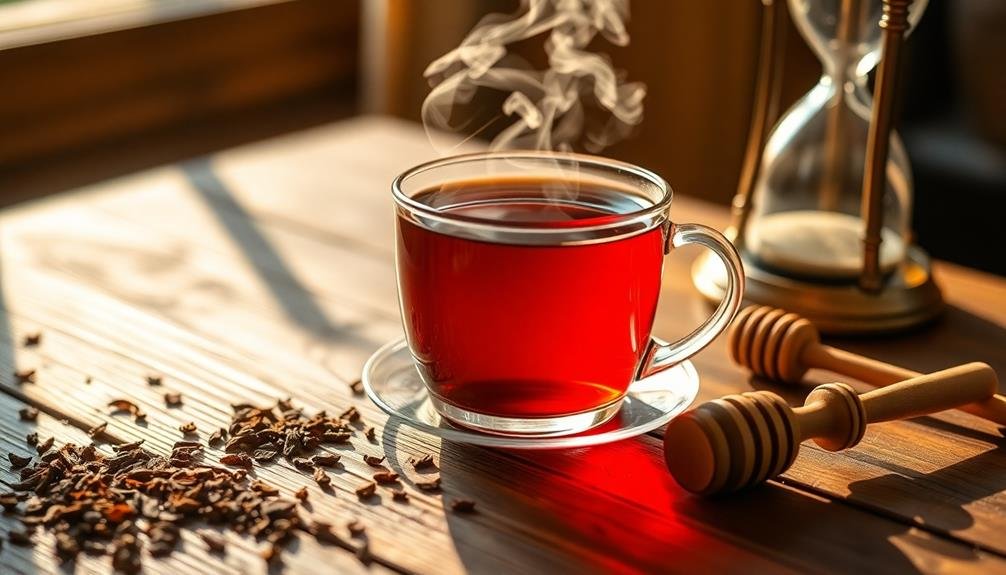
Rooibos and honeybush, two popular South African herbal teas, have unique steeping requirements. Unlike true teas from the Camellia sinensis plant, these caffeine-free alternatives can withstand longer steeping times without becoming bitter.
For rooibos, you'll want to steep for 5 to 7 minutes in water that's just off the boil (around 200°F or 93°C). This extended steeping time allows the full flavor profile to develop, bringing out the tea's natural sweetness and nutty undertones. If you prefer a stronger brew, you can safely steep for up to 10 minutes without risking an overly astringent taste.
Honeybush, on the other hand, benefits from an even longer steeping time. Aim for 7 to 10 minutes in water that's also just off the boil. This longer steep helps extract the tea's characteristic honey-like sweetness and subtle floral notes. For a more robust flavor, you can steep honeybush for up to 15 minutes without compromising its smooth taste.
Both rooibos and honeybush are forgiving teas, so don't worry if you accidentally over-steep them. They'll remain flavorful and won't develop the bitterness associated with over-steeped true teas.
Yerba Mate Infusion Duration
Yerba mate, a traditional South American beverage, requires a unique approach to steeping. Unlike other teas, yerba mate is typically brewed multiple times from the same leaves.
For your first infusion, you'll want to steep the leaves for about 3-5 minutes in water that's around 160-180°F (70-80°C). This initial steep will produce a robust, flavorful brew.
For subsequent infusions, you can adjust the steeping time based on your taste preferences:
- Short steeps (1-2 minutes): Lighter, more delicate flavor
- Medium steeps (3-4 minutes): Balanced, full-bodied taste
- Long steeps (5-7 minutes): Stronger, more intense flavor
Fruit Tea Mixture Steeping
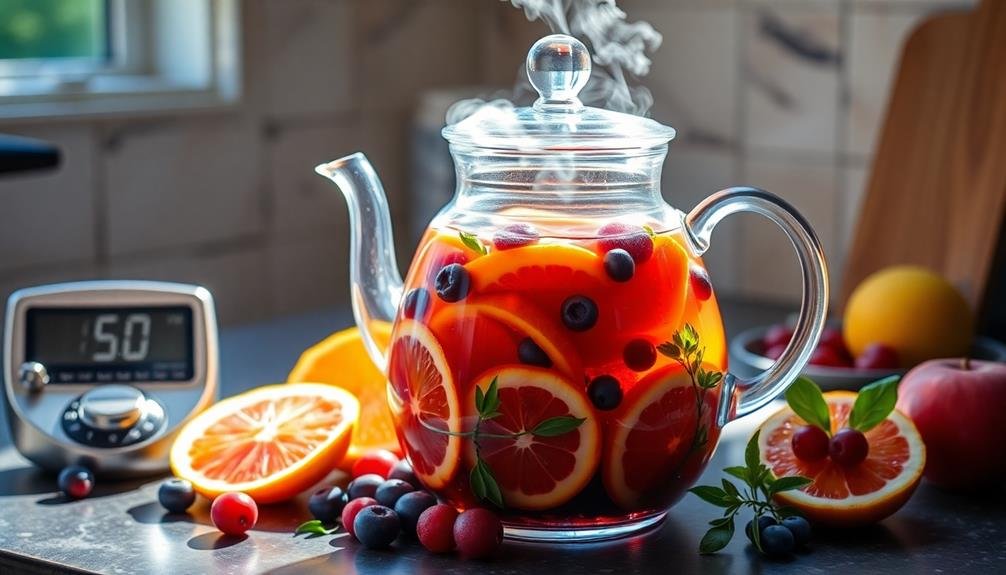
Fruit tea mixtures offer a burst of vibrant flavors and aromas, making them a popular choice for both hot and cold brews. When steeping these blends, you'll want to strike a balance between extracting the fruity essence and avoiding bitterness. Generally, fruit teas require shorter steeping times than traditional black or green teas.
For hot fruit tea, steep your mixture for 3 to 5 minutes in water that's just below boiling (around 200°F or 93°C). This temperature allows the fruit flavors to infuse without scorching delicate ingredients. If you're using a blend that includes herbs or flowers, you might need to adjust the steeping time slightly.
For cold brew fruit tea, you'll want to let it steep longer. Place your fruit tea mixture in cold water and refrigerate for 4 to 12 hours, depending on the strength you prefer. This method produces a smoother, less acidic brew that's perfect for summer refreshment.
Floral Tea Blend Timing
When crafting floral tea blends, you'll need to contemplate the varying steeping times for different flowers.
Delicate blooms like chamomile and lavender require shorter infusions, while more robust flowers such as hibiscus and rose hips benefit from longer steeping periods.
To achieve a balanced flavor profile, you'll want to carefully time the addition of each floral component, allowing the subtle notes to shine without overpowering the overall blend.
Delicate Flower Infusions
Delicate floral teas require a gentle touch when it comes to steeping. These fragrant blends often contain delicate petals and buds that can easily become bitter if over-steeped. To preserve their subtle flavors and aromas, you'll want to keep your steeping times short and your water temperature lower than you'd use for heartier teas.
For most delicate flower infusions, aim for a steeping time of 2-3 minutes. Use water that's around 175°F (80°C), which is just below boiling. This cooler temperature helps extract the tea's delicate essence without scorching the petals. Remember, you can always steep for longer if you prefer a stronger flavor, but you can't undo over-steeping.
Some popular delicate flower infusions and their ideal steeping times include:
- Chamomile: 3-5 minutes
- Lavender: 2-3 minutes
- Jasmine: 1-3 minutes
When steeping these teas, use about 1 teaspoon of dried flowers per cup of water. You'll know your tea is ready when it has a light, pleasant aroma and a pale color. Trust your senses and adjust the steeping time to suit your taste preferences.
Robust Herbal Bouquets
Unlike their more delicate counterparts, robust herbal bouquets can handle longer steeping times and hotter water temperatures.
These hearty blends often include ingredients like chamomile, peppermint, rooibos, and ginger, which release their flavors more slowly and can withstand extended brewing without becoming bitter.
For most robust herbal bouquets, you'll want to use water that's just off the boil, around 200°F (93°C).
Steep your blend for 5-7 minutes to extract the full range of flavors and beneficial compounds. If you prefer a stronger taste, you can even let it steep for up to 10 minutes without risking over-extraction.
When crafting your own robust herbal blends, consider combining complementary flavors.
Pair earthy roots like dandelion or burdock with bright, minty herbs for balance. Add a touch of licorice root or stevia leaf for natural sweetness.
Don't be afraid to experiment with longer steeping times to find your perfect brew.
Remember, herbal teas don't contain caffeine, so you won't risk making them too strong or jittery.
Enjoy the rich, full-bodied flavors that come from properly steeping your robust herbal bouquets.
Balancing Floral Notes
Floral tea blends present a unique challenge when it comes to steeping times. You'll need to balance delicate flavors without letting them become overpowering or bitter. Most floral teas benefit from a shorter steeping time, typically between 2 to 4 minutes. This allows the subtle notes to infuse without becoming too intense.
When working with floral blends, consider these key factors:
- Water temperature: Use cooler water, around 175-185°F (80-85°C), to prevent scorching delicate petals.
- Tea-to-water ratio: Start with 1 teaspoon of blend per 8 ounces of water.
- Steeping vessel: Opt for a glass or ceramic teapot to maintain consistent temperature.
Experiment with your blend to find the perfect balance. Start with a 2-minute steep and taste every 30 seconds until you achieve the desired flavor profile.
Remember, some flowers like chamomile and lavender can become bitter if steeped too long. For stronger blends, increase the amount of tea rather than the steeping time.
If you're combining floral notes with other ingredients, adjust your steeping time to accommodate the longest-steeping component while preventing overextraction of the floral elements.
Frequently Asked Questions
How Does Water Temperature Affect Steeping Time for Different Tea Blends?
Water temperature greatly impacts steeping time for tea blends. You'll find that hotter water extracts flavors faster, requiring shorter steeps. Cooler temperatures need longer steeping times. Adjust accordingly to avoid over-extraction or weak brews for your perfect cup.
Can I Reuse Tea Leaves for Multiple Steepings?
Yes, you can reuse tea leaves for multiple steepings. You'll get different flavors with each infusion. However, the strength will decrease with each steep. It's best for whole leaf teas, especially oolongs and pu-erhs.
What's the Best Way to Store Homemade Tea Blends?
Store your homemade tea blends in airtight containers away from light, heat, and moisture. You'll want to keep them in a cool, dark place like a pantry. Don't forget to label them with the blend name and date.
How Do Altitude and Humidity Impact Tea Steeping Times?
You'll need to adjust your steeping times at higher altitudes. Water boils at lower temperatures, so you'll steep longer. In humid environments, you might reduce steeping time slightly as moisture can affect tea's absorption rate.
Are There Health Risks Associated With Over-Steeping Certain Tea Blends?
You can face health risks from over-steeping certain tea blends. You'll potentially consume excessive tannins, leading to nausea or digestive issues. Caffeine levels may increase, causing jitters or sleep problems. Some herbs might release harmful compounds if steeped too long.
In Summary
You've now got the knowledge to steep your perfect cup every time. Remember, these guidelines are just starting points. Don't be afraid to experiment and adjust steeping times to suit your taste. You'll soon discover your ideal brew for each blend. Whether you're a tea novice or connoisseur, mastering these steeping times will elevate your tea experience. So grab your favorite blend, set your timer, and enjoy the perfect cup you've crafted.

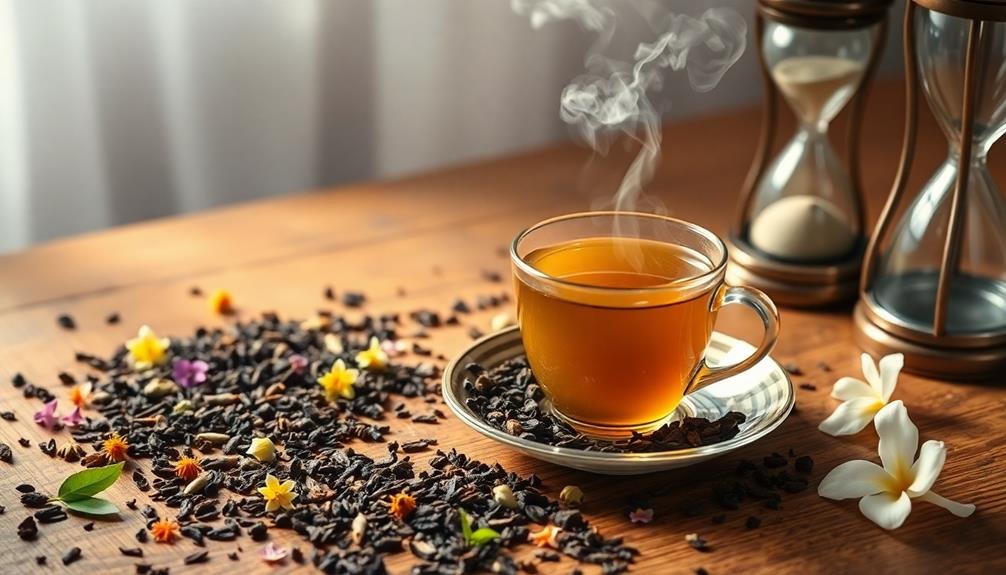
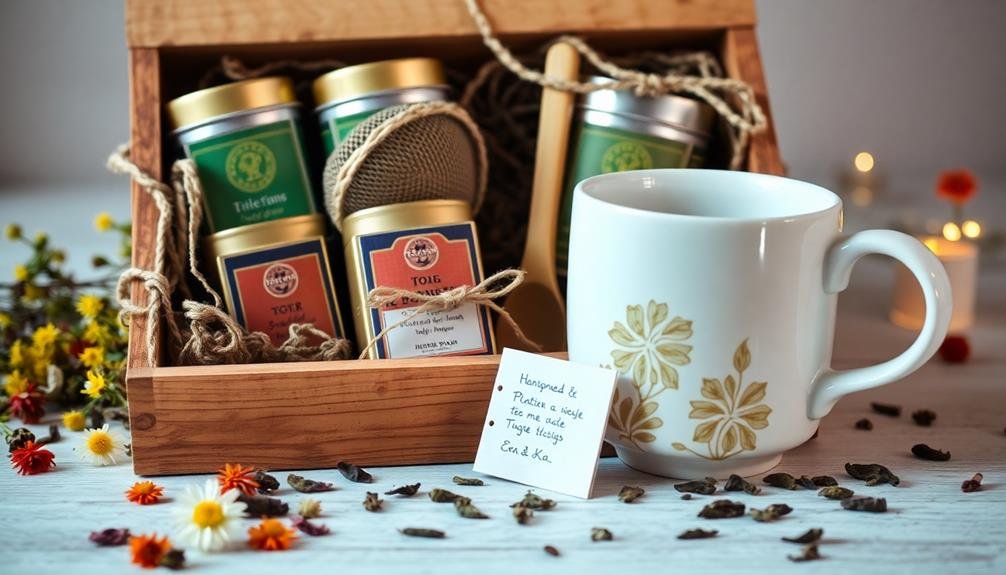
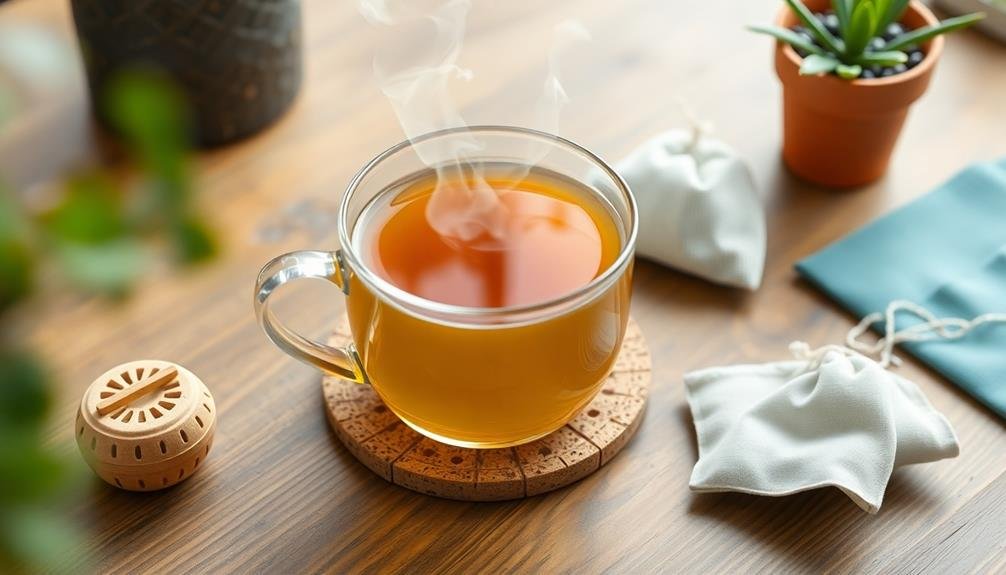
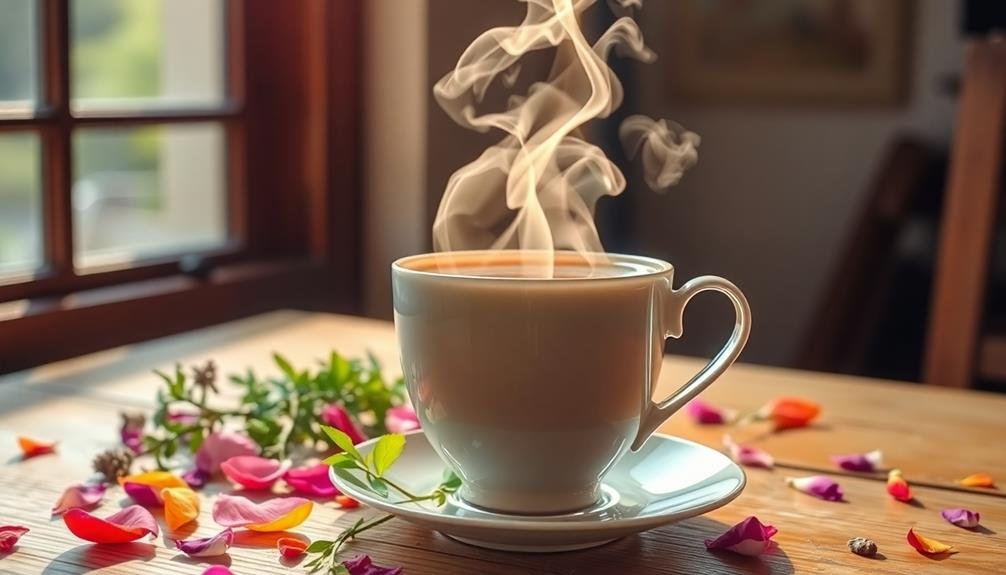
Leave a Reply